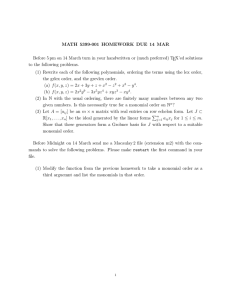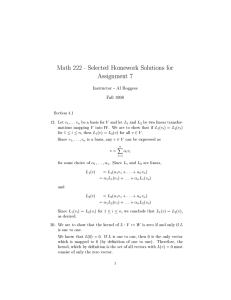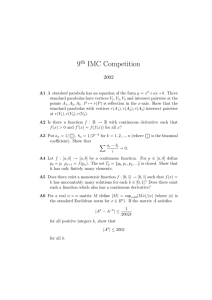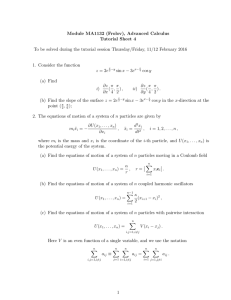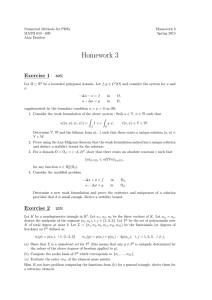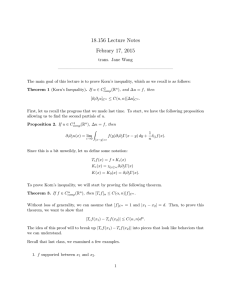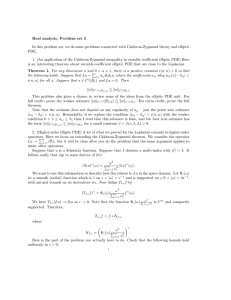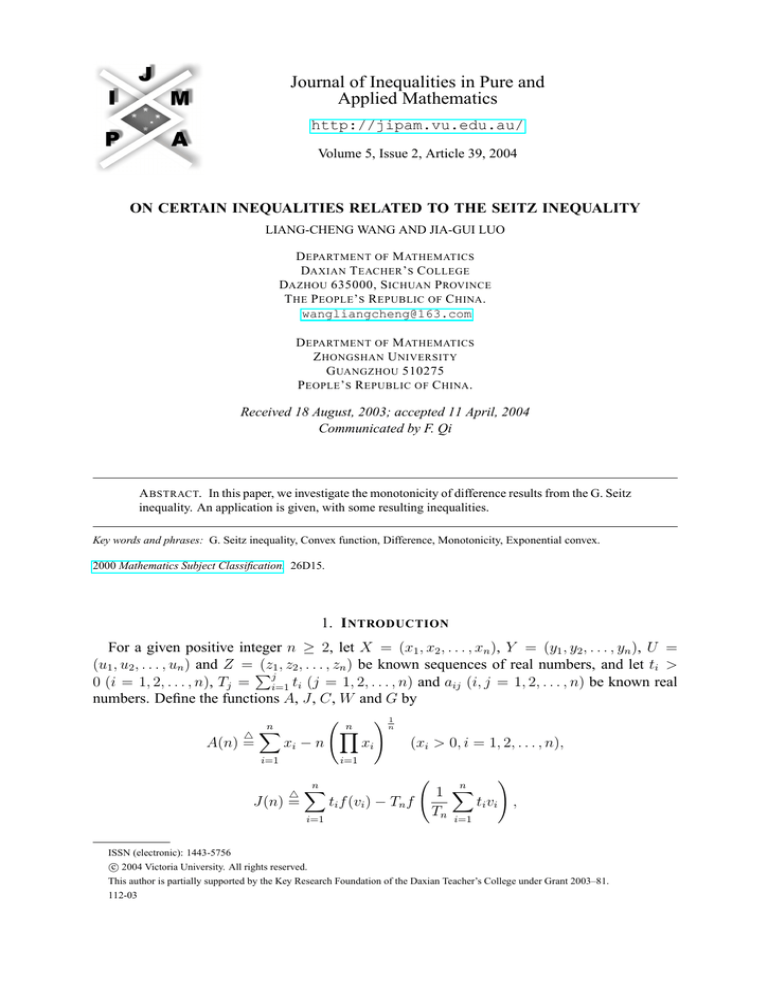
Journal of Inequalities in Pure and
Applied Mathematics
http://jipam.vu.edu.au/
Volume 5, Issue 2, Article 39, 2004
ON CERTAIN INEQUALITIES RELATED TO THE SEITZ INEQUALITY
LIANG-CHENG WANG AND JIA-GUI LUO
D EPARTMENT OF M ATHEMATICS
DAXIAN T EACHER ’ S C OLLEGE
DAZHOU 635000, S ICHUAN P ROVINCE
T HE P EOPLE ’ S R EPUBLIC OF C HINA .
wangliangcheng@163.com
D EPARTMENT OF M ATHEMATICS
Z HONGSHAN U NIVERSITY
G UANGZHOU 510275
P EOPLE ’ S R EPUBLIC OF C HINA .
Received 18 August, 2003; accepted 11 April, 2004
Communicated by F. Qi
A BSTRACT. In this paper, we investigate the monotonicity of difference results from the G. Seitz
inequality. An application is given, with some resulting inequalities.
Key words and phrases: G. Seitz inequality, Convex function, Difference, Monotonicity, Exponential convex.
2000 Mathematics Subject Classification. 26D15.
1. I NTRODUCTION
For a given positive integer n ≥ 2, let X = (x1 , x2 , . . . , xn ), Y = (y1 , y2 , . . . , yn ), U =
(u1 , u2 , . . . , un ) and Z = (z1 , z2 , . . . , zn ) be known sequences of real numbers, and let ti >
P
0 (i = 1, 2, . . . , n), Tj = ji=1 ti (j = 1, 2, . . . , n) and aij (i, j = 1, 2, . . . , n) be known real
numbers. Define the functions A, J, C, W and G by
! n1
n
n
X
Y
4
A(n) =
xi − n
xi
(xi > 0, i = 1, 2, . . . , n),
i=1
i=1
4
J(n) =
n
X
i=1
ti f (vi ) − Tn f
!
n
1 X
ti vi ,
Tn i=1
ISSN (electronic): 1443-5756
c 2004 Victoria University. All rights reserved.
This author is partially supported by the Key Research Foundation of the Daxian Teacher’s College under Grant 2003–81.
112-03
2
L IANG -C HENG WANG
AND J IA -G UI
L UO
where f is convex function on the interval I and vi ∈ I(i = 1, 2, . . . , n),
!# 21
! n
" n
n
X
X
X
4
2
2
yi
C(n) =
xi
−
xi yi ,
i=1
i=1
4
W (n) = Tn
n
X
n
X
ti xi zi −
i=1
i=1
!
ti xi
i=1
n
X
!
ti zi ,
i=1
and
4
G(n) =
n
X
!
aij xi zj
i,j=1
n
X
!
aij yi uj
−
i,j=1
n
X
!
aij xi uj
i,j=1
n
X
!
aij yi zj
.
i,j=1
Rade investigated the monotonicity of difference for A − G mean inequality, and obtained
the following inequality [2]
A(n) ≥ A(n − 1).
(1.1)
P. M. Vasić and J. E. Pečarić generalized inequality (1.1) to convex functions, and obtained
the following inequality [4, 6]
J(n) ≥ J(n − 1).
(1.2)
Recently the first author and Xu Zhang studied inequality (1.2) in depth, and obtained some
inequalities. L.-C. Wang also obtained some applications, one of them is the following inequality [8]
C(n) ≥ C(n − 1).
(1.3)
Inequality (1.3) resulted from the Cauchy inequality
! n
!
!2
n
n
X
X
X
(1.4)
x2i
yi2 ≥
xi yi .
i=1
i=1
i=1
In [7], L.-C. Wang proved the following inequality
W (n) ≥ W (n − 1),
(1.5)
with X and Z both increasing or both decreasing. If one of X or Z is increasing and the other
decreasing, then the inequality (1.5) reverses.
Inequality (1.5) resulted from the following Chebyshev inequality
! n
!
n
n
X
X
X
(1.6)
Tn
ti xi zi ≥
ti xi
ti zi ,
i=1
i=1
i=1
with X and Z both increasing or both decreasing. If one of X or Z is increasing and the other
decreasing, then the inequality (1.6) reverses.
Assume that i, j, r, s ∈ N such that 1 ≤ i < j ≤ n and 1 ≤ r < s ≤ n, we have
xi xj zr zs (1.7)
y i y j ur u s ≥ 0
and
(1.8)
J. Inequal. Pure and Appl. Math., 5(2) Art. 39, 2004
air ais
ajr ajs
≥ 0.
http://jipam.vu.edu.au/
O N C ERTAIN I NEQUALITIES R ELATED
TO THE
S EITZ I NEQUALITY
3
When both (1.7) and (1.8) are true, the following inequality by G. Seitz [1] holds:
n
P
i,j=1
n
P
(1.9)
n
P
aij xi zj
≥
aij xi uj
i,j=1
i,j=1
n
P
aij yi zj
.
aij yi uj
i,j=1
If
(
(1.10)
X = Z,
Y =U
and aij =
1 i=j
(i, j = 1, 2, . . . , n),
0 i 6= j
then inequality (1.9) changes into (1.4). If
(
Y = U = (1, 1, . . . , 1) and aij =
(1.11)
ti i = j
(i, j = 1, 2, . . . , n),
0 i 6= j
then inequality (1.9) changes into (1.6).
In this paper, we investigate inequality (1.9) in depth, obtaining the following main result.
Theorem 1.1. If both inequalities (1.7) and (1.8) are true, then we have
G(n) ≥ G(n − 1).
(1.12)
Remark 1.2. If we put (1.10) and (1.11) into (1.12), then (1.12) becomes (1.3) and (1.5), respectively. Hence, (1.12) is an extension of (1.3) and (1.5).
2. P ROOF OF T HEOREM 1.1
Using
aij xi zj
aij yi uj
ain yi un = aij yi zj
ain xi zn = aij xi uj
ain xi un
ain yi zn
(i, j = 1, 2, . . . , n − 1),
(i, j = 1, 2, . . . , n − 1),
and (1.7) – (1.8), we have
(2.1)
n−1
X
aij xi zj
i,j=1
n−1
X
ain yi un −
i=1
+
aij yi uj
i,j=1
=
aij xi zj
n−1 X
n−1
X
n−1
X
n−1
X
ain xi zn −
akn yk un −
aij yi uj
J. Inequal. Pure and Appl. Math., 5(2) Art. 39, 2004
n−1
X
aij xi uj
i,j=1
n−1
X
k=1
akn xk zn −
n−1
X
ain yi zn
i=1
n−1 X
n−1
X
aij yi zj
i=1 j=1
k=1
i=1 j=1
ain xi un
i=1
i=1
i=1 j=1
+
aij yi zj
n−1
X
i,j=1
n−1
X
n−1 X
n−1
X
n−1
X
n−1 X
n−1
X
i=1 j=1
n−1
X
akn xk un
k=1
aij xi uj
n−1
X
akn yk zn
k=1
http://jipam.vu.edu.au/
4
L IANG -C HENG WANG
=
n−1 X
n−1 X
n−1
X
AND J IA -G UI
L UO
aij akn xi zj yk un + xk zn yi uj − yi zj xk un − xi uj yk zn
i=1 j=1 k=1,k6=i
=
n−1
n−2 X
n−1
X
X
j=1
=
+
i=1 k=2,i<k
n−2 X
n−1
n−1 X
X
!
n−1 X
n−2
X
aij akn xi zj yk un + xk zn yi uj − yi zj xk un − xi uj yk zn
i=2 k=1,i>k
aij akn xi zj yk un + xk zn yi uj − yi zj xk un − xi uj yk zn
j=1 i=1 k=2,i<k
+
n−1 X
n−2
n−1 X
X
akj ain xk zj yi un + xi zn yk uj − yk zj xi un − xk uj yi zn
j=1 k=2 i=1,k>i
=
n−1
X X
aij akn − akj ain
xi zj yk un + xk zn yi uj − yi zj xk un − xi uj yk zn
j=1 1≤i<k<n
n−1
X
X aij ain
=
akj akn
j=1 1≤i<k<n
xi xk zj zn yi yk uj un ≥ 0.
Using
anj yn uj = aij xi uj anj yn zj
aij xi zj
aij yi uj
(i, j = 1, 2, . . . , n − 1),
anj xn zj = aij yi zj anj xn uj
(i, j = 1, 2, . . . , n − 1),
(1.7) – (1.8) and the same method as in the proof of (2.1), we obtain
n−1
X
(2.2)
n−1
X
aij xi zj
i,j=1
anj yn uj −
j=1
n−1
X
aij xi uj
i,j=1
+
n−1
X
aij yi uj
i,j=1
=
n−1
X
n−1 X
n−1
X
n−1
X
anj xn zj −
j=1
n−1
X
anj yn zj
j=1
n−1
X
aij yi zj
i,j=1
n−1
X
anj xn uj
j=1
aij ank xi zj yn uk + yi uj xn zk − xi uj yn zk − yi zj xn uk
i=1 j=1 k=1,k6=j
=
n−1
X
X
i=1 1≤j<k<n
aij aik
anj ank
xi xn zj zk yi yn uj uk ≥ 0.
Using
ain yi un
ajn xj zn = ain yi zn
ajn xj un
(i, j = 1, 2, . . . , n)
and
ani yn ui
anj xn zj = ani yn zi anj xn uj
(i, j = 1, 2, . . . , n − 1),
we obtain
(2.3)
n
X
i=1
ain yi un
n
X
j=1
J. Inequal. Pure and Appl. Math., 5(2) Art. 39, 2004
ajn xj zn −
n
X
i=1
ain yi zn
n
X
ajn xj un = 0
j=1
http://jipam.vu.edu.au/
O N C ERTAIN I NEQUALITIES R ELATED
TO THE
S EITZ I NEQUALITY
5
and
n−1
X
(2.4)
ani yn ui
i=1
respectively.
Using
ann yn un
anj yn uj
n−1
X
anj xn zj −
n−1
X
j=1
n−1
X
ani yn zi
i=1
anj xn zj = anj yn zj
ann xn zn = ann yn zn
anj xn uj = 0,
j=1
ann xn un
anj xn uj
(j = 1, 2, . . . , n − 1),
(j = 1, 2, . . . , n − 1),
and (1.7) – (1.8), we have
(2.5)
n
X
ain yi un
i=1
n−1
X
anj xn zj −
j=1
anj yn uj
j=1
+
n
X
ain xi zn −
=
aij ann xi zj yn un −
i,j=1
n−1
X
aij ann yi uj xn zn −
+
ain yi un
n−1
X
anj xn zj −
j=1
anj yn uj
n−1
X
anj xn uj
!
aij ann yi zj xn un
!
aij ann xi uj yn zn
anj yn zj
ain xi zn −
i=1
n−1 X
n−1
X
ain yi zn
i=1
aij ann xi zj yn un −
n−1 X
n−1
X
i=1 j=1
n−1 X
n−1
X
n−1 X
n−1
X
aij ann yi uj xn zn −
n−1
X
!
ain xi un
i=1
n−1
X
i=1 j=1
n−1 X
n−1
X
!
j=1
j=1
n−1
X
i=1 j=1
=
ain yi zn
n−1
X
i,j=1
j=1
+
n−1
X
n−1
X
i=1
+
n
X
i,j=1
n−1
X
ain xi un
i=1
i,j=1
n−1
X
!
i=1
i=1
n−1
X
+
anj yn zj
n
X
j=1
n−1
X
+
n−1
X
n−1
X
!
anj xn uj
j=1
!
aij ann yi zj xn un
!
aij ann xi uj yn zn
i=1 j=1
ain anj yi un xn zj + xi zn yn uj − xi un yn zj − yi zn xn uj
i=1 j=1
+
n−1 X
n−1
X
aij ann xi zj yn un + xn zn yi uj − yi zj xn un − xi uj yn zn
i=1 j=1
=
n−1 X
n−1 X
aij ann − ain anj
xi zj yn un + xn zn yi uj − yi zj xn un − xi uj yn zn
i=1 j=1
n−1 X
n−1 X
aij ain
=
anj ann
i=1 j=1
J. Inequal. Pure and Appl. Math., 5(2) Art. 39, 2004
xi xn zj zn yi yn uj un ≥ 0.
http://jipam.vu.edu.au/
6
L IANG -C HENG WANG
AND J IA -G UI
L UO
By (2.1)-(2.5) and definition of G(n), we have
G(n) − G(n − 1) =
n−1
X
aij xi zj +
i,j=1
n
X
ain xi zn +
i=1
n−1
X
×
−
aij yi uj +
i,j=1
×
n
X
−
aij yi zj +
=
aij xi zj
n−1
X
n−1
X
n−1
X
+
ain xi un +
+
ain yi un −
aij yi uj
+
+
+
+
n−1
X
!
anj yn zj
n−1
X
aij xi uj
aij yi zj
i,j=1
aij yi zj
n−1
X
!
ain xi un
i=1
!
n−1
X
aij ann yi zj xn un
n−1
X
ain xi zn −
i=1
n−1
X
aij xi uj
i,j=1
aij ann yi uj xn zn −
!
n−1
X
ain yi zn
i=1
!
n−1
X
aij ann xi uj yn zn
i,j=1
aij xi zj
n−1
X
anj yn uj −
n−1
X
aij xi uj
n−1
X
j=1
i,j=1
j=1
n−1
X
n−1
X
n−1
X
n−1
X
aij yi uj
anj xn zj −
aij yi zj
i,j=1
j=1
i,j=1
j=1
n
X
n
X
n
X
n
X
ain yi un
ajn xj zn −
ain yi zn
i=1
j=1
i=1
j=1
n−1
X
n−1
X
n−1
X
n−1
X
ani yn ui
anj xn zj −
ani yn zi
!
ajn xj un
!
anj xn uj
i=1
j=1
n
X
n−1
X
n−1
X
n
X
ain yi un
anj xn zj −
anj yn zj
j=1
j=1
i=1
n−1
X
n
X
n
X
n−1
X
anj yn uj
i=1
ain xi zn −
i=1
ain yi zn
anj yn zj
anj xn uj
j=1
i=1
!
!
i=1
j=1
!
n−1
X
i,j=1
+
+
anj xn uj
j=1
i,j=1
i,j=1
n−1
X
!
i,j=1
i,j=1
+
anj yn uj
i,j=1
aij ann xi zj yn un −
n−1
X
n−1
X
ain yi zn +
n−1
X
i,j=1
n−1
X
!
j=1
n
X
aij yi uj −
i=1
n−1
X
j=1
i,j=1
aij xi zj
i,j=1
ain yi un +
i=1
i,j=1
n−1
X
n
X
i=1
i,j=1
n−1
X
anj xn zj
i=1
aij xi uj +
n−1
X
!
j=1
i,j=1
n−1
X
n−1
X
!
ain xi un
!
anj xn uj
j=1
≥ 0,
J. Inequal. Pure and Appl. Math., 5(2) Art. 39, 2004
http://jipam.vu.edu.au/
O N C ERTAIN I NEQUALITIES R ELATED
TO THE
S EITZ I NEQUALITY
7
i.e., inequality (1.12) is true. This completes the proof of theorem .
3. A PPLICATIONS
Let E be a convex subset of an arbitrary real linear space K, and let f : E 7→ (0, +∞). f is
an exponential convex function on E, if and only if
(3.1)
f tu + (1 − t)v ≤ f t (u)f 1−t (v)
for any u, v ∈ E and any t ∈ [0, 1]. f is an exponential concave function on E, if and only if
the inequality (3.1) reverses (see [4]).
For any u, v ∈ E(u 6= v) and αki , βki ∈ [0, 1], we let xki = αki u + (1 − αki )v and yki =
βki u + (1 − βki )v (k = 1, 2; i = 1, 2, . . . , n; n > 2). Define a function L by
L(n) =
n
X
i,j=1
aij f (x1i )f (x2j )
n
X
aij f (y1i )f (y2j ) −
i,j=1
n
X
aij f (x1i )f (y2j )
i,j=1
n
X
aij f (y1i )f (x2j ).
i,j=1
Proposition 3.1. Let f be an exponential convex (or concave) function on E and inequality
(1.8) be true. For k = 1, 2 and every pair of positive integers i and j such that 1 ≤ i < j ≤ n,
if
αki ≤ βki ≤ αkj
(3.2)
and
αkj − αki = βkj − βki ,
then we have
L(n) ≥ L(n − 1).
(3.3)
Proof.
(1) Suppose f is an exponential convex function on E. For k = 1, 2 and 1 ≤ i <
j ≤ n, from (3.2), we have βkj = αkj + βki − αki ≥ αkj .
Case 1. When αki < βki ≤ αkj < βkj , we take t =
Hence, we have
(3.4)
βki −αki
,
βkj −αki
then 1 − t =
βkj −βki
.
βkj −αki
tykj + (1 − t)xki = βki u + (1 − βki )v = yki .
From (3.1) and (3.4), we have
(3.5)
f (yki ) ≤ f t (ykj )f 1−t (xki ).
From (3.2), we get the other form of t and 1 − t: t =
we have
(3.6)
βkj −αkj
βkj −αki
and 1 − t =
αkj −αki
.
βkj −αki
Then
(1 − t)ykj + txki = αkj u + (1 − αkj )v = xkj .
From (3.1) and (3.6), we have
(3.7)
(3.8)
(3.9)
f (xkj ) ≤ f 1−t (ykj )f t (xki ).
From (3.5) and (3.7), we obtain
f (xki ) f (xkj )
f (yki ) f (ykj )
≥ 0.
Case 2. When αki = βki (or αkj = βkj ), by (3.2), then we have αkj = βkj (or αki =
βki ). Hence, the equality of (3.8) holds.
For any 1 ≤ i < j ≤ n and any 1 ≤ r < s ≤ n, by (3.8), we obtain
f (x1i ) f (x1j ) f (x2r ) f (x2s ) f (y1i ) f (y1j ) f (y2r ) f (y2s ) ≥ 0.
J. Inequal. Pure and Appl. Math., 5(2) Art. 39, 2004
http://jipam.vu.edu.au/
8
L IANG -C HENG WANG
AND J IA -G UI
L UO
(2) Let f be an exponential concave function on E. Then (3.5), (3.7) and (3.8) reverse.
Hence, (3.9) is still valid.
Replacing xi , yi , zi and ui in Theorem 1.1 with f (x1i ), f (y1i ), f (x2i ) and f (y2i )(i =
1, 2, . . . , n), respectively, we obtain (3.3). This completes the proof of Proposition 3.1.
Remark 3.2. In Proposition 3.1, when E is a real interval I, we only need
xki ≤ yki ≤ xkj
and xkj − xki = ykj − yki ,
where k = 1, 2, i, j are every pair of positive integers such that 1 ≤ i < j ≤ n, xki , xkj , yki , ykj ∈
I.
In order to verify Proposition 3.4, the following lemma is necessary.
Lemma 3.3. Let c, d : [a, b] 7→ R (b > a) be the monotonic functions, both increasing or both
decreasing. Furthermore, let q : [a, b] 7→ (0, +∞) be an integrable function. Then
Z b
Z b
Z b
Z b
(3.10)
q(x)c(x)dx
q(x)d(x)dx ≤
q(x)dx
q(x)c(x)d(x)dx.
a
a
a
a
If one of the functions of c or d is increasing and the other decreasing, then the inequality (3.10)
reverses. (see [2, 3]).
Let p : [a, b] 7→ (0, +∞) be continuous, g : [a, b] 7→ (1, +∞) be monotonic continuous.
Define a function M by
M (n) =
n
X
(k+i)
aij h
(m+j)
(x)h
(x)
i,j
n
X
aij h(l+i) (x)h(w+j) (x)
i,j
−
n
X
(k+i)
aij h
(w+j)
(x)h
i,j
(x)
n
X
aij h(l+i) (x)h(m+j) (x),
i,j
where k, l, m, w ∈ N, i, j = 1, 2, . . . , n and
(3.11)
Z
+
h : R 7→ R ,
h(x) =
b
x
p(t) g(t) dt (see [5]).
a
Proposition 3.4. Let the inequalities in (1.8) hold. If k < l, m < w or k > l, m > w, then we
have
M (n) ≥ M (n − 1).
(3.12)
Proof. For (3.11), by continuity of p and g, we may change the order of derivation and integration. By direct computation, we get
Z b
(n)
p(t) (g(t))x (ln g(t))n dt.
(3.13)
h (x) =
a
For every pair of integers i, j such that 1 ≤ i < j ≤ n, when k < l, replace q, c and d in Lemma
3.3 by p(t) (g(t))x (ln g(t))k+i , (ln g(t))j−i and (ln g(t))l−k , respectively. Using (3.13), we get
(3.14)
h(k+i) (x)h(l+j) (x) ≥ h(k+j) (x)h(l+i) (x).
By (3.14), we have
(3.15)
(k+i)
(k+j)
h
(l+i) (x) h (l+j) (x)
h
(x) h
(x)
J. Inequal. Pure and Appl. Math., 5(2) Art. 39, 2004
≥ 0.
http://jipam.vu.edu.au/
O N C ERTAIN I NEQUALITIES R ELATED
TO THE
S EITZ I NEQUALITY
9
Similarly we obtain
(3.16)
(m+r)
h
(x) h(m+s) (x)
(w+r)
h
(x) h(w+s) (x)
≥ 0,
where r, s are pair of integer such that 1 ≤ r < s ≤ n and m < w.
Replacing xi , yi , zi and ui in Theorem 1.1 by h(k+i) (x), h(l+i) (x), h(m+i) (x) and h(w+i) (x)(i =
1, 2, . . . , n), respectively, we obtain (3.12).
By Lemma 3.3, when k > l and m > w, both (3.15) and (3.16) reverse. Hence, the product
on the left for both (3.15) and (3.16) is still nonnegative, hence, by Theorem 1.1, (3.12) is also
satisfied.
This completes the proof of Proposition 3.4.
R EFERENCES
[1] G. SEITZ, Une remarque aux inégalités, Aktuarské Vědy, 6 (1936), 167–171.
[2] D.S. MITRINOVIĆ, Analytic Inequalities, Springer-Verlag, Berlin/New York, 1970.
[3] BAI-NI GUO AND FENG QI, Inequalities for generalized weighted mean values of convex function,
Math. Ineq. Appl., 4(2) (2001), 195–202.
[4] CHUNG-LIE WANG, Inequalities of the Rado-Popoviciu type for functions and their applications,
J. Math. Anal. Appl., 100 (1984), 436–446.
[5] FENG QI, Generalized weighted mean values with two parameters , Proc. R. Soc. Lond. A., 454
(1998), 2723–2732.
[6] P.M. VASIĆ AND J.E. PEČARIĆ, On the Jensen inequality, Univ. Beograd. Publ. Elektrotehn. Fak.
Ser. Math. Fiz., 634–677 (1979), 50–54.
[7] L.-C. WANG, On the monotonicity of difference generated by the inequality of Chebyshev type, J.
Sichuan University (Natural Science Edition), 39 (2002), 338–403.
[8] L.-C. WANG, Convex Functions and Their Inequalities, Sichuan University Press, Chengdu, China,
2001. (In Chinese).
J. Inequal. Pure and Appl. Math., 5(2) Art. 39, 2004
http://jipam.vu.edu.au/

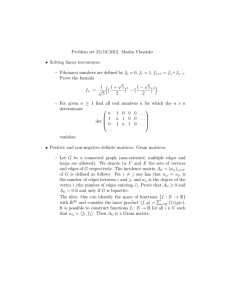
![1. Let R = C[x].](http://s2.studylib.net/store/data/010491179_1-9a9c70e395518f466f652079f02ae14a-300x300.png)

